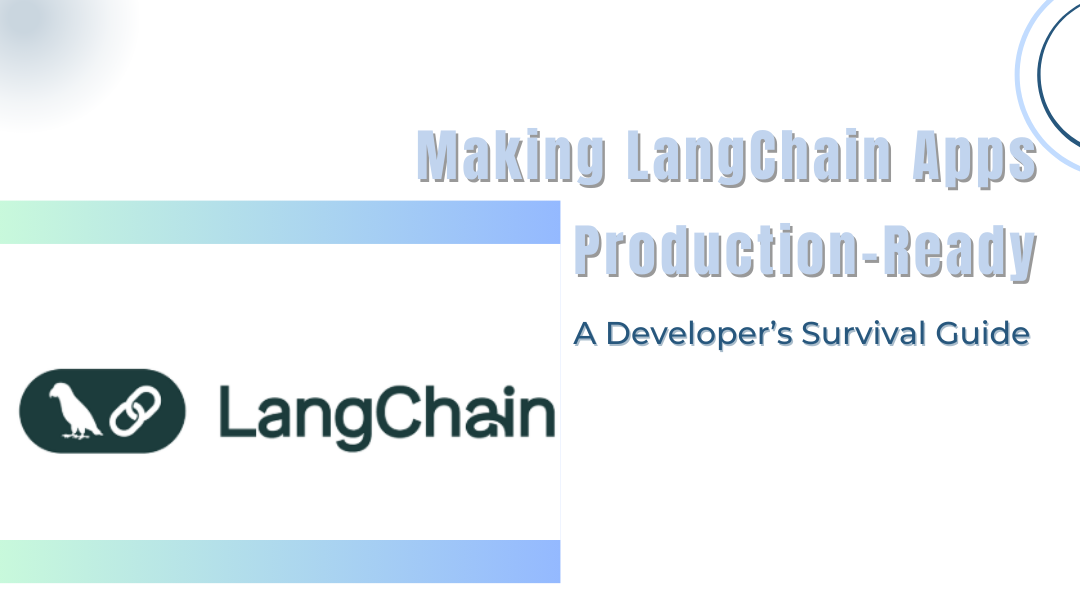Building a LangChain prototype is fun, but deploying it without crashing, burning through your API budget, or frustrating users? That’s where the real work begins. Here’s how to harden your AI app for the real world.
1. Optimize Like Your Budget Depends on It (Because It Does)
Memory: Stop Hogging Resources
Problem: Chatbots that remember every word eventually choke on their own history.
Fix: Summarize past convos instead of storing them verbatim.
python
Copy
Download
from langchain.memory import ConversationSummaryMemory
from langchain.llms import OpenAI
llm = OpenAI(model=”gpt-4″)
memory = ConversationSummaryMemory(llm=llm) # Keeps the gist, ditches the fluff
chatbot = ConversationChain(llm=llm, memory=memory)
Why it works: Like recalling “we talked about pizza toppings” instead of memorizing every topping mentioned.
Caching: Don’t Pay to Answer the Same Thing Twice
Problem: Users ask identical questions (“What’s your refund policy?”). Each call costs you API credits.
Fix: Cache responses like a web browser.
python
Copy
Download
from functools import lru_cache
@lru_cache(maxsize=100) # Remembers the last 100 answers
def get_cached_response(question):
return chatbot.run(question)
# First call hits the API. Next time? Instant reply from cache.
print(get_cached_response(“How do reset my password?”))
Async: Make Your App Multitask
Problem: Your bot freezes when handling 10 users at once.
Fix: Process requests concurrently.
python
Copy
Download
import asyncio
from concurrent.futures import ThreadPoolExecutor
executor = ThreadPoolExecutor(max_workers=5) # 5 queries at once
async def handle_query(query):
loop = asyncio.get_running_loop()
return await loop.run_in_executor(executor, chatbot.run, query)
# Answer 3 questions simultaneously
queries = [“Status of my order?”, “Store hours?”, “Contact support?”]
results = asyncio.run(asyncio.gather(*[handle_query(q) for q in queries]))
Pro Tip: Pair this with caching—async + cached responses = chef’s kiss.
2. Avoid Getting Rate-Limited (Or Banned)
APIs hate being spammed. Here’s how to play nice:
Throttling: Slow Your Roll
python
Copy
Download
import time
def polite_api_call(query):
time.sleep(1.5) # 1.5 sec delay between calls
return chatbot.run(query)
When to use: If your API docs say *”50 requests/minute max.”*
Retries: Because APIs Flake Out Sometimes
Smart retries wait longer after each failure:
python
Copy
Download
import random
def fetch_with_retries(query, max_attempts=3):
for attempt in range(max_attempts):
try:
return chatbot.run(query)
except Exception as e:
wait_time = (2 ** attempt) + random.uniform(0, 1) # 1s, then 3s, then 7s
print(f”Failed! Retrying in {wait_time:.1f}s…”)
time.sleep(wait_time)
raise Exception(“API is down. Panic (or notify admin).”)
For Heavy Workloads: Queue It Up
Tools to try:
- Celery + Redis for self-hosted setups.
- AWS SQS if you’re on the cloud.
3. The Full Package: A Battle-Ready Chatbot
python
Copy
Download
from langchain.memory import ConversationSummaryMemory
from langchain.llms import OpenAI
from functools import lru_cache
import asyncio
from concurrent.futures import ThreadPoolExecutor
# Configure the bot
llm = OpenAI(model=”gpt-4″)
memory = ConversationSummaryMemory(llm=llm)
chatbot = ConversationChain(llm=llm, memory=memory)
# Cache aggressively
@lru_cache(maxsize=200)
def cached_response(query):
return chatbot.run(query)
# Handle traffic surges
executor = ThreadPoolExecutor(max_workers=10)
async def async_query(query):
loop = asyncio.get_running_loop()
return await loop.run_in_executor(executor, cached_response, query)
# Example: Crush 20 queries without breaking a sweat
queries = [“Track order #123”, “What’s new?”, “Reset password”, …] # 20+ questions
results = asyncio.run(asyncio.gather(*[async_query(q) for q in queries]))
Before vs. After Optimization
| Metric | Naive Approach | Optimized |
| Speed | Slower than a DMV line | Near-instant for cached queries |
| API Costs | $100/month | $20/month |
| User Experience | “Why’s it freezing?!” | “Wow, so fast!” |
Key Takeaways
- Summarize memories – Your servers will thank you.
- Cache everything – Especially FAQs.
- Go async – Users hate waiting in line.
- Respect rate limits – Or get cut off.
Final thought: Optimization isn’t glamorous, but it’s what separates toy projects from pro apps. Now go deploy something that doesn’t suck.
